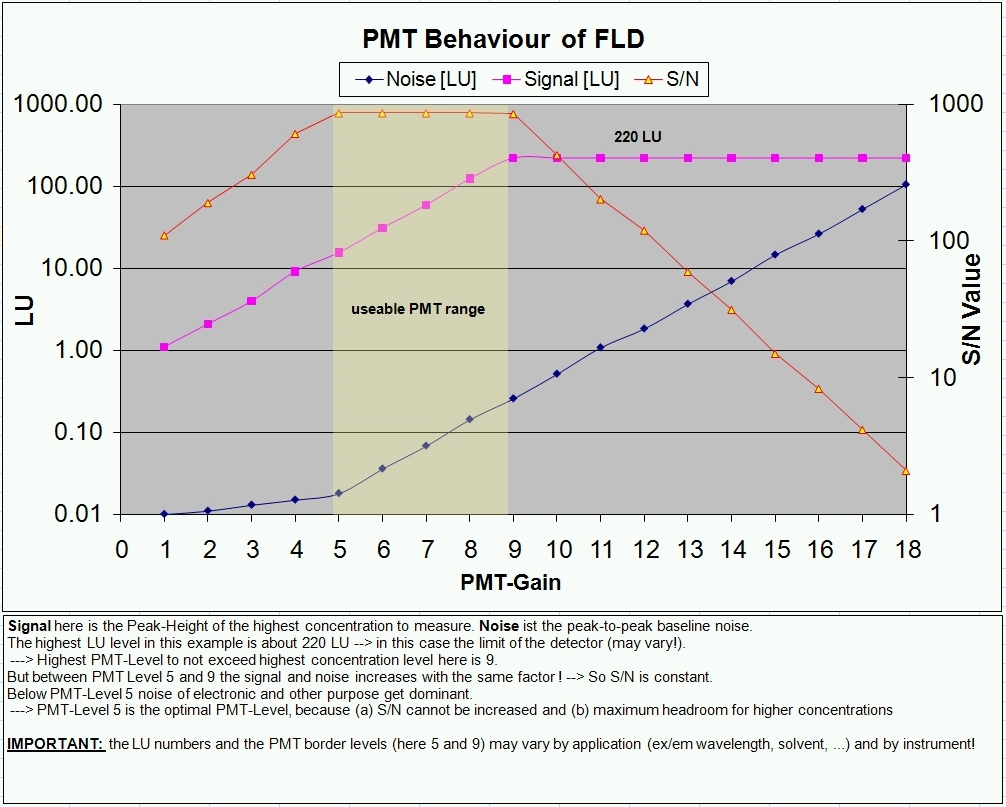Optimize the PMT-Gain-Level
Start the PMT-Gain-Test with your operating conditions (used method parameter, EX-/EM-wavelength, solvent, flow rate, …). The resulting PMT value will give you the best signal to noise performance with the maximum usable signal range for this method and this specific instrument. For another FLD this PMT level may vary (based on the individual PMT-Gain-Test).
The figure below demonstrates the impact of changing the PMT Gain.

In this example the maximum output is around 220 LU and further increase of the PMT (above 9) results in a signal overload (clipping) and drop of signal to noise value.
-
Set the PMT-Gain Level
Now check with your highest concentration amount, that your highest peak does not clip or overflow.
If this check is ok, you finished the PMT-Gain-Level optimization. Continue with "Set your Luminescence Units in LU".
If the check shows that the highest concentration doesn't fit to the selected range (e.g. by clipping), you may decrease the sensitivity of your FLD by gradually decreasing the PMT-Level by 1 to get roughly half the signal height by each step. Be aware that by that step you will lose sensitivity at low signal levels (LOD).
Set your Luminescence Units in LU.
If you are not satisfied with the LU output level of the detector or if you want to align the output of multiple instruments with different output levels you can scale each instrument output.
The recommended setting of the FLD is around 100 LU for the highest peak height to get optimum signal to noise and signal range. Lower LU values normally do not influence the performance of the instrument if PMT-Gain Test was executed fine.
For analog out less than 100 LU is optimum to get best analog signal performance with the default attenuation of 100 LU/ 1 V. Adapt your LU setting such that your maximum signal level under default attenuation is between 50 to 80 LU (analog output equivalent to 500 mV to 800 mV).
After correct PMT Setting you can scale any instrument to your favorable LU level. We recommend not exceeding around 100 LU. The parameter of choice is called 'Scale factor' and is applicable by the local controller, the Instant Pilot (B.02.07 or later).
In case older revisions are used, the 'Scale factor' can be entered using the command line of
Agilent ChemStation:
PRINT SENDMODULE$(LFLD,"DMUL x.xx")Instant Pilot: Service Mode – FLD, then type
DMUL x.xxand press SEND.LAN/RS-232 Firmware Update Tool: via Send Instruction menu:
DMUL x.xxAgilent Lab Advisor Software: via Instruction menu:
DMUL x.xx
This setting is resident to the instrument even for firmware updates and is independent of the software environment.
The level of LU is no measure of instrument sensitivity! At the lowest concentration limit (limit of detection), the signal to noise (for example by Raman S/N Test) is the only measure that can accurately be used to compare chromatograms and results and to confirm the performance of the instrument.
For low background and highest sensitivity keep the flow cell clean and always use fresh water to prevent biological background from native fluorescence by algae and bacteria.
base-id: 3585950091
id: 3585950091